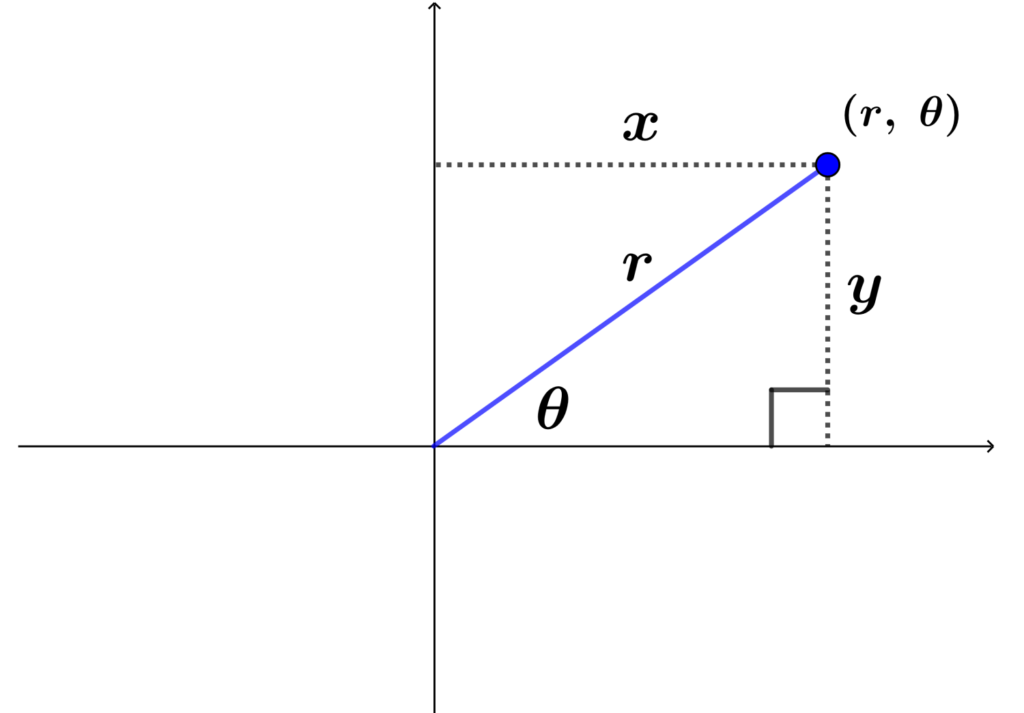The polar coordinates are defined using the distance, r, and the angle, θ. On the other hand, rectangular coordinates, also known as Cartesian coordinates, are defined by x and by y. We can find equations that relate these coordinates using a right triangle and the trigonometric functions sine and cosine.
Here, we will learn about the formulas that we can use to transform from polar to rectangular coordinates. Then, we will apply these formulas by solving some practice problems.
TRIGONOMETRY

Relevant for…
Learning to transform from polar to rectangular coordinates.
TRIGONOMETRY

Relevant for…
Learning to transform from polar to rectangular coordinates.
How to transform from polar coordinates to rectangular coordinates?
Polar coordinates have the form $latex (r, \theta)$, where r is the distance of the point from the origin and θ is the angle formed by the line and the x-axis. Rectangular coordinates or Cartesian coordinates have the form $latex (x, y)$.
To transform from polar coordinates to rectangular coordinates, we use trigonometry and relate these two coordinates.
Let’s consider the following diagram:

Clearly, we see that we can find the x-coordinates using the cosine function and we can find the y-coordinates using the sine function. Therefore, we have the formulas:
| $latex x=r~\cos(\theta)$ $latex y=r~\sin(\theta)$ |
Area of an isosceles triangle – Examples with answers
The following examples are solved by applying the transformation formulas from polar coordinates to rectangular coordinates. Try to solve the problems yourself before looking at the answer.
EXAMPLE 1
If we have a point with polar coordinates $latex (5, \frac{\pi}{3})$, what are its rectangular coordinates?
Solution
We can observe the values $latex r = 5$ and $latex \theta = \frac{\pi}{3}$. We use the formulas found above to convert to rectangular coordinates. Therefore, the value of x is found using the cosine function:
$latex x=r~\cos(\theta)$
$latex x=5~\cos(\frac{\pi}{3})$
$latex x=5(0.5)$
$latex x=2.5$
The value of y is found using the sine function:
$latex y=r~\sin(\theta)$
$latex y=5~\sin(\frac{\pi}{3})$
$latex y=5(0.866)$
$latex y=4.33$
Therefore, the rectangular coordinates are (2.5, 4.33).
EXAMPLE 2
A point has the polar coordinates $latex (12, \frac{4 \pi}{3})$. What are its rectangular coordinates?
Solution
We start by recognizing the values $latex r = 12$ and $latex \theta = \frac{4 \pi}{3}$. We convert these coordinates by applying the formulas seen above. Therefore, we find the value of x using the cosine function:
$latex x=r~\cos(\theta)$
$latex x=12~\cos(\frac{4\pi}{3})$
$latex x=12(-0.5)$
$latex x=-6$
Now, we find the value of y using the sine function:
$latex y=r~\sin(\theta)$
$latex y=12~\sin(\frac{4\pi}{3})$
$latex y=12(-0.866)$
$latex y=-10.4$
Therefore, the rectangular coordinates are (-6, -10.4).
EXAMPLE 3
What are the rectangular coordinates of the point $latex (11, \frac{5 \pi}{4})$ that is written in polar coordinates?
Solution
From the given coordinates, we have the values $latex r = 11$ and $latex \theta = \frac{5 \pi}{4}$. We substitute these values in the transformation formulas to find the rectangular coordinates. Therefore, the value of x is found using the cosine function:
$latex x=r~\cos(\theta)$
$latex x=11~\cos(\frac{5\pi}{4})$
$latex x=11(-0.707)$
$latex x=-7.78$
The value of y is found using the sine function:
$latex y=r~\sin(\theta)$
$latex y=11~\sin(\frac{5\pi}{4})$
$latex y=11(-0.707)$
$latex y=-7.78$
Therefore, the rectangular coordinates are (-7.78, -7.78).
EXAMPLE 4
If a point has polar coordinates $latex (20, \frac{\pi}{5})$, what are its rectangular coordinates?
Solution
We have the values $latex r = 20$ and $latex \theta = \frac{\pi}{5}$. We find the value of x by using the cosine function and substituting these values:
$latex x=r~\cos(\theta)$
$latex x=20~\cos(\frac{\pi}{5})$
$latex x=20(0.809)$
$latex x=16.18$
We find the value of y using the sine function:
$latex y=r~\sin(\theta)$
$latex y=20~\sin(\frac{\pi}{5})$
$latex y=20(0.588)$
$latex y=11.76$
Therefore, the rectangular coordinates are (16.18, 11.76).
Polar to rectangular coordinates – Practice problems
Practice what you have learned about transforming polar to rectangular coordinates by solving the following problems. If you need help with this, you can look at the solved examples above.
See also
Interested in learning more about polar coordinates? Take a look at these pages:



